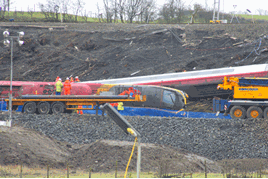Rail accident investigation was rather losing its way in the early 2000s. The scramble to apportion blame and demonstrate to the public that something was being done quickly meant that uncoordinated responses to accidents hindered a thorough railway investigation of an incident. It was not a situation that could be allowed to continue, if safety on the network was ever to improve.
In the wake of the Ladbroke Grove rail disaster on October 5 1999 (when 31 people lost their lives in a head-on collision between two passenger trains), Lord Cullen launched a public inquiry into not only the accident itself, but also the management and regulation of rail safety as a whole.
Cullen concluded that the UK should set up an independent accident investigation body - a need that was reinforced by an EU Directive passed in 2004 requiring each member state to have its own accident investigation organisation, independent of regulator and industry.
And so the Rail Accident Investigation Branch (RAIB) was born. The UK Government passed the Railways & Transport Safety Act of 2003, creating powers to form the new organisation. Career railway engineer Carolyn Griffiths, who had joined British Rail in 1979, was appointed to lead the new organisation. Griffiths stepped down from the role earlier this year, after 12 years as the RAIB’s leader. Simon French is currently the acting chief inspector, pending a permanent appointment.
Setting up the RAIB meant negotiations into what its relationship should be with the various bodies that already had an interest in railway safety - the industry itself, the police, and the Health and Safety Executive (HSE, into which Her Majesty’s Railway Inspectorate had been transferred in 1990).
Investigators and support staff had to be recruited and trained, offices found and equipment acquired, all at the same time as the detailed legal framework under which the whole thing would operate was being developed. It was a once-in-a-lifetime opportunity to start with a clean sheet and set up an organisation that would investigate thoroughly, efficiently and without fear or favour.
RAIL readers with long memories may recall that back in July 2004, while the RAIB was still in gestation, Nigel Harris interviewed Griffiths. He asked her how her new organisation was going to function, and the difference it might make to the way in which accidents and incidents on the UK’s railways and tramways were investigated. It’s now been ten years since the RAIB began its operational life on October 17 2005… so what has it achieved since then?
RAIB now employs 24 investigators (known as inspectors by the law). They are split into four teams, each headed by a principal inspector, and divided equally between two bases - at Derby and Aldershot. Each inspector was recruited for their expertise in railways, accident investigation and related topics, and all have extensive experience in their fields.
Of the 22 inspectors and principals in post when the Branch (as the RAIB is also affectionately known) began operations in 2005, 11 are still serving. Four have since retired and seven have moved on to pastures new. This continuity has enabled the RAIB to build up a considerable (and respected) bank of skills and knowledge.
The RAIB’s inspectors provide an on-call team of at least four people (two from each office) who are available continuously, prepared to go anywhere in the country at 30 minutes’ notice, in response vehicles containing all the equipment needed for an on-site investigation.
Their response is driven by a duty co-ordinator, drawn from a pool of trained inspectors, and who is on duty to take phone calls 24 hours a day, seven days a week. Notification of an incident usually reaches the Branch soon after it happens. If it becomes apparent that an event may warrant urgent on-site investigation, the duty co-ordinator will despatch a team to investigate.
Frequent training exercises to test the readiness of the team and refresh their skills are an important part of day-to-day RAIB operations. There are also 18 support and administrative staff split between the two offices, and some of these are also available to attend investigation sites to provide technical and logistical assistance.
Over the past decade, RAIB investigators have been deployed to sites more than 450 times.
Not all of those call-outs have led to published reports, as it is sometimes clear from a preliminary examination of a site that there are no safety lessons to be learned. Even so, the Branch has published more than 300 reports and bulletins in the public domain (all of which can be read on the RAIB website: www.gov.uk/raib). The full investigation reports, which include recommendations for changes that need to be made to improve safety, are the main output of the Branch.
Sometimes an investigation may reveal that although an incident has identified shortcomings in the way things were being done, it’s not actually necessary to recommend changes to equipment or systems. In such cases, RAIB publishes a bulletin to inform the industry and the public about the event, and to highlight learning points that can be used in briefings to staff (such as the importance of properly carrying out the requirements of the railway’s rule book).














Login to comment
Comments
No comments have been made yet.